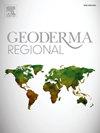Based on soil carbon saturation capacity what is the potential for soil carbon improvement in rice-based cropping systems of northwest region of Bangladesh?
IF 3.3
2区 农林科学
Q2 SOIL SCIENCE
引用次数: 0
Abstract
The regional study determined soil organic carbon (SOC) saturation capacity and deficit of rice-based cropping systems (RBCS) in a range of land resource, crop and management combinations to identify which RBCS had the greatest potential for improving SOC. Six RBCS were examined and the crop-diversified and mustard-rice triple cropping systems in medium highland (MHL) had the greatest potential with the highest carbon saturation capacity and lowest carbon deficit. This finding was largely attributed to the location of these RBCS where the soil's dominant clay mineral types (1:1 or 2:1 clays) and level of inundation resulted in a higher proportion of fine soil particles compared to the other RBCS. Higher SOC levels recorded in these systems, hence the lower soil carbon deficit, was also partly due to greater carbon inputs from three annual crops and greater retention of crop residue. In contrast, maize-rice, wheat-rice, and vegetable-rice triple cropping systems on highland (HL) had less potential for soil carbon improvement. The location of these RBCS in HL areas, which are prone to SOC loss through soil erosion, combined with less crop diversity, low crop residue retention and greater soil disturbance through tillage further reduces the likelihood of SOC increases. Largely due to these management factors the most vulnerable RBCS is rice-rice double cropping system on MHL, which has a 76 % deficit to carbon saturation capacity, despite a more favorable land resource. To address soil carbon deficits, especially under vulnerable soil types, various management strategies could be applied, including: optimal fertilization, use of organic manures, crop rotations, and greater crop residue retention. Enhancing soil resilience is crucial for maintaining productivity, especially in high tillage systems. Greater crop diversity and increased residue retention could improve carbon sequestration, benefiting soil health and climate change mitigation. Promoting crop-diversified and mustard-rice systems among smallholder farmers in suitable regions of the Floodplain and Terrace soil physiography throughout Bangladesh, is recommended, while other systems with higher soil carbon deficits require increased carbon inputs, by reducing fallow periods and crop residue removal in the region. Support for smallholders through access to land of greater land capability, subsidized inputs, and agricultural extension activities is essential for enhancing soil resilience and productivity in RBCS.

基于土壤碳饱和容量,孟加拉国西北地区以水稻为基础的种植系统改善土壤碳的潜力是什么?
区域研究确定了不同土地资源、作物和管理组合下稻基种植系统(RBCS)的土壤有机碳(SOC)饱和容量和亏缺,以确定哪些RBCS对改善有机碳(SOC)的潜力最大。对6种RBCS进行了研究,结果表明,中高原作物-多样化和芥菜-水稻三熟体系的潜力最大,碳饱和容量最高,碳亏缺最低。这一发现在很大程度上归因于这些RBCS的位置,其中土壤的主要粘土矿物类型(1:1或2:1粘土)和淹没水平导致细土颗粒的比例高于其他RBCS。在这些系统中记录的较高的有机碳水平,因此较低的土壤碳赤字,也部分是由于三年期作物的更多碳输入和作物残留物的更多保留。相比之下,玉米-水稻、小麦-水稻和蔬菜-水稻三熟系统对土壤碳的改善潜力较小。这些RBCS位于土壤侵蚀容易导致有机碳流失的HL地区,加上作物多样性少、作物残茬保留率低、耕作对土壤的干扰较大,进一步降低了有机碳增加的可能性。在很大程度上由于这些管理因素,MHL上最脆弱的RBCS是水稻-水稻双作制度,尽管土地资源更有利,但其碳饱和容量仍有76%的赤字。为了解决土壤碳赤字问题,特别是在脆弱土壤类型下,可以采用各种管理策略,包括:优化施肥、使用有机肥料、作物轮作和增加作物残留物保留。提高土壤恢复力对保持生产力至关重要,特别是在高耕制中。增加作物多样性和增加秸秆保有量可以改善碳固存,有利于土壤健康和减缓气候变化。建议在孟加拉国洪泛平原和阶地土壤地形适宜地区的小农中推广作物多样化和芥菜稻系统,而其他土壤碳赤字较高的系统则需要通过减少该地区的休耕期和清除作物残茬来增加碳投入。通过获得土地容量更大的土地、补贴投入物和农业推广活动来支持小农,对于提高RBCS的土壤恢复力和生产力至关重要。
本文章由计算机程序翻译,如有差异,请以英文原文为准。
求助全文
约1分钟内获得全文
求助全文
来源期刊

Geoderma Regional
Agricultural and Biological Sciences-Soil Science
CiteScore
6.10
自引率
7.30%
发文量
122
审稿时长
76 days
期刊介绍:
Global issues require studies and solutions on national and regional levels. Geoderma Regional focuses on studies that increase understanding and advance our scientific knowledge of soils in all regions of the world. The journal embraces every aspect of soil science and welcomes reviews of regional progress.
 求助内容:
求助内容: 应助结果提醒方式:
应助结果提醒方式:


